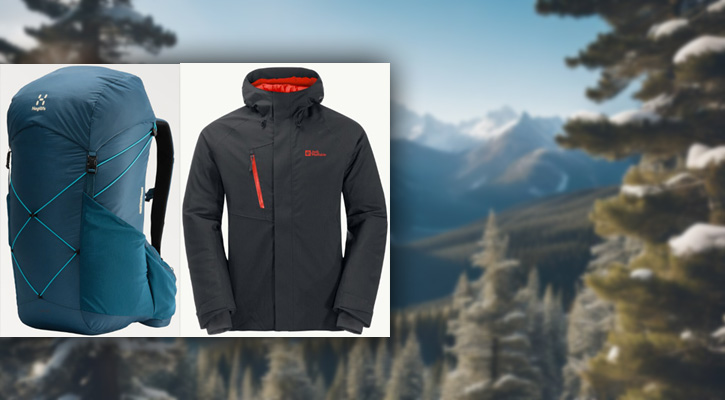
Haglöfs has been crafting clothing for Nordic outdoor enthusiasts for many decades. Their jackets, pants, and base layers are built to keep hikers and climbers warm and dry even in sub-zero temperatures.
Jack Wolfskin also has a long history of producing great outdoor gear, dating back to the 1980s in Germany. While they offer gear for casual wear, their outdoor lines focus on technical features. Their jackets use breathable, waterproof fabrics to shield you from wind and rain without restricting movement.
But which of the two is better for you?
In this article, we’ll explore the history, products, materials, and prices of each brand so you can have a clearer idea about which is better for your needs and budget.
Let’s begin!
Contents:
1. Haglöfs Outdoor Gear
History of the Brand
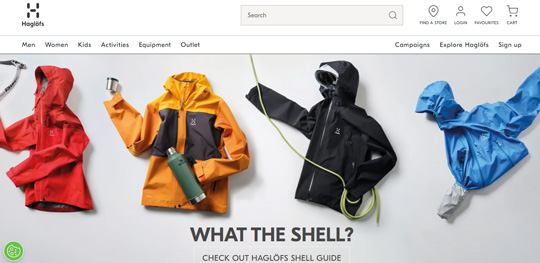
Haglöfs official website
In 1914, Wiktor Haglöf, originally a carpenter, established the Haglöfs brand in Sweden with the goal of producing a durable backpack suitable for diverse travel conditions within the nation.
Since then, the company has expanded its product range and remains committed to pioneering advancements in craftsmanship. Haglöfs is deeply committed to conserving the natural environment for the benefit of future generations.
The brand advocates for outdoor exploration, believing that individuals can engage with nature in all weather conditions, both physically and mentally.
Don’t miss:
9 Swedish Outdoor Clothing and Jackets Brands: Our Favorites
7 Backpack Brands from Sweden: Our Favorites
Materials, Fabrics, and Production Process
Haglöfs is dedicated to decreasing their carbon footprint by 50% before 2030. Their efforts include utilizing sustainable materials and renewable energy, enhancing energy efficiency, and involving consumers in minimizing their environmental impact.
The company is incorporating recycled and natural materials like organic cotton, hemp, and Lyocell/Tencel to develop new products suitable for outdoor pursuits and sports.
Also, Haglöfs is implementing eco-friendly dyeing methods and reducing plastic bag usage. They are also committed to responsible chemical, water, and energy management in their production facilities.
The brand utilizes the Higg Index to evaluate the sustainability of its products across their entire life cycle. With regard to animal-based materials, Haglöfs is dedicated to sourcing from suppliers that adhere to high standards for animal welfare, ecosystem preservation, and biodiversity protection.
For example, their natural down is certified by the Responsible Down Standard (RDS) to ensure ethical sourcing practices.
Haglöfs also incorporates various technologies in its products for protection, warmth, and breathability, such as Recycled Polyamide (Nylon), Recycled Polyester, Mimic PLATINUM Ultracluster Graphene insulation, and GORE-TEX membranes in their jackets, among others.
The video will be loaded from YouTube.com, a third party. If you play it, you accept their terms of service, and their use of cookies.
Read also:
Haglöfs vs Arc’teryx Outdoor Gear: A Comparison
Haglöfs vs Mammut: Which is Better for Outdoor Equipment?
Where is Haglöfs outdoor gear made?
Haglöfs equipment is primarily produced in Asian nations like China and Vietnam, as well as in European nations such as Poland and Romania. The company’s dedication to superior standards has bolstered its appeal in numerous countries, particularly in Scandinavia.
Recommended Products
Haglöfs L.I.M GTX Active Men’s Jacket
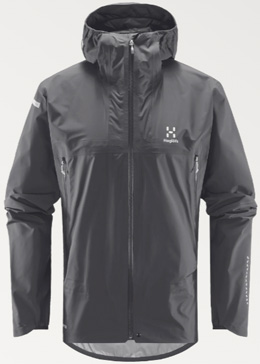
Image: haglofs.com
Check it out at Haglofs.com
The Haglöfs L.I.M GTX Active Jacket offers a lightweight technical shell suitable for summer activities, delivering weather protection, breathability, and comfort through a blend of durable GORE-TEX Active 3-layer and GORE-TEX Paclite® Plus 2.5-layer fabric.
This jacket features an athletic fit, an adaptable hood, elastic cuffs and bottom hem for enhanced fit, reflective trims for safety, and two zippered hand pockets with mesh ventilation. It is ideal for backpacking and hiking and can be machine-washed.
Haglöfs L.I.M 35 Hiking Backpack
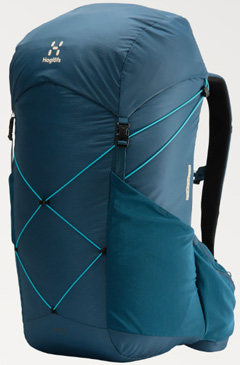
Image: haglofs.com
Check it out at Haglofs.com
The Haglöfs L.I.M 35 Hiking Backpack, weighing 920 grams and offering a volume of 35 liters, is specifically crafted for trekking and hiking. Its Airback suspension system ensures optimal carrying comfort during rigorous activities by facilitating ventilation and airflow through the back contact area.
Notable features include elastic side pockets, zippered elastic hip belt pockets, and an elastic cord for compression and gear attachment. It’s hydration system compatible, equipped with a fixed top lid with a pocket, an adjustable sternum strap, a padded hip belt, and load lifters.
Constructed from bluesign® approved 70D*140D Diamond Rip-stop Polyamide, this backpack excels in lightweight durability and functionality.
Prices
Haglöfs typically offers products within the mid-to-high price range. Their jackets are priced between $100 and upwards of $600 for the most advanced styles, while their bags and backpacks range from $60 to $300.
Are Haglöfs products worth the price?
We think they are! Considering the multitude of technologies, emphasis on environmental responsibility, and diverse selection of outdoor equipment, we are of the opinion that this brand is a good investment.
Read next: 11 European Brands for Outdoor Enthusiasts: Our Top Picks
2. Jack Wolfskin Outdoor Gear
History of the Brand
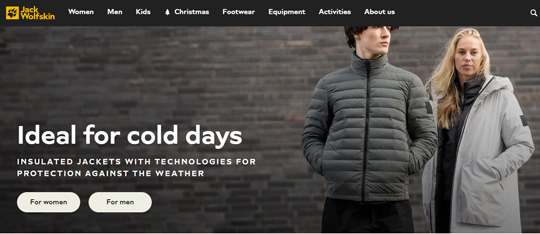
Jack Wolfskin’s official website
You may have come across Jack Wolfskin, particularly if you reside in Europe. Established in 1981 in Frankfurt by Ulrich Dausien, this German brand has been headquartered in Idstein, Germany since 1997.
Over time, due to increasing demand and market share, Jack Wolfskin has evolved into one of Germany’s leading outdoor brands, offering a diverse range of products. It has gained popularity not only in Germany but also in other European countries.
Presently, the brand provides a broad selection of gear for various outdoor pursuits, encompassing apparel, footwear, tents, sleeping bags, backpacks, and more.
Jack Wolfskin has long been committed to sustainability, environmental causes, and social accountability, like numerous other outdoor apparel and equipment brands nowadays. This dedication is reflected in its products, making it an exemplary model of a conscientious enterprise.
Both individuals seeking high-quality casual wear and those in search of exceptional outdoor gear are drawn to the company’s designs and performance.
Don’t miss:
9 German Jackets and Outdoor Clothing Brands that You’ll Love
Jack Wolfskin vs Arc’teryx: Which Brand is Better?
Materials, Fabrics, and Production Process
A large quantity of Polyester is utilized each year in the production of outdoor gear. Jack Wolfskin is a brand that is careful when it comes to its environmental impact and incorporates recycled polyester in its products whenever feasible.
It is essential to have suitable insulation choices for your clothing, especially for winter jackets. And Jack Wolfskin in this sector doesn’t disappoint!
It utilizes a mix of natural and synthetic materials for insulation, such as RDS-certified Natural Down, PrimaLoft (synthetic), Microguard (synthetic), and Fibercloud (synthetic).
Regarding fabric technologies, in its coats and sportswear, Jack Wolfskin employs mainly Texapore, a fabric that is windproof, breathable, and waterproof, as well as water-resistant and suitable for snowy conditions.
Texapore is offered in various options and protection levels suitable for a range of activities.
The video will be loaded from YouTube.com, a third party. If you play it, you accept their terms of service, and their use of cookies.
Read also:
Columbia vs Jack Wolfskin: Which is Better?
Jack Wolfskin vs The North Face Outdoor Gear: A Comparison
Where is Jack Wolfskin’s outdoor gear made?
Products from Jack Wolfskin are manufactured in both European and Asian countries. Their production facilities are situated across various Asian nations such as Vietnam, China, Bangladesh, and South Korea. They also have a presence in Germany, Slovenia, Italy, and Turkey within Europe. The sourcing of their raw materials spans across Europe, the USA, and Asia. (source)
Recommended Products
Jack Wolfskin Troposphere Men’s Insulated Jacket
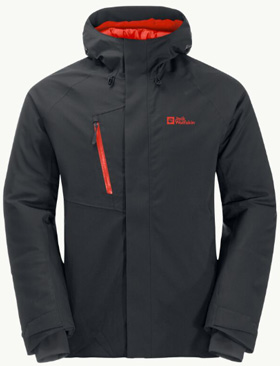
Image: jack-wolfskin.com
Check it out at Jack-Wolfskin.com
The Troposphere jacket by Jack Wolfskin is a simple yet highly practical and flexible insulated hardshell jacket. It is made with Texapore Pro fabric, which offers excellent windproof, waterproof, and breathable properties, ensuring protection from the elements while allowing heat and moisture to escape, thus enhancing freedom of movement.
This jacket is insulated with PrimaLoft Black Rise fill, a water-resistant recycled synthetic fiber insulation, providing warmth in cold conditions. It includes three outer pockets and one inner pocket for secure storage of small items.
Additionally, it incorporates recycled materials, reflecting Jack Wolfskin’s commitment to environmental sustainability in its production. Designed for active outdoor use in cold and wet conditions, the Troposphere combines technical materials with insulated construction for optimal performance.
Jack Wolfskin Highland Trail 50+5 Women’s Trekking Pack
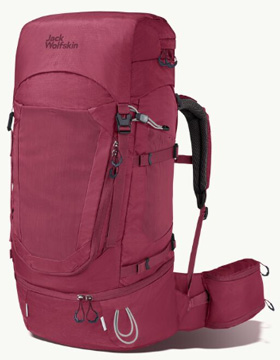
Image: jack-wolfskin.com
Check it out at Jack-Wolfskin.com
The Highland Trail 50+5 Backpack has been specifically crafted for female users, featuring a tailored ergonomic design and women-specific elements. Boasting a generous capacity of 50+5 liters, it offers ample space for extended excursions.
The backpack incorporates a height-adjustable X-Transition back system, renowned for its exceptional comfort, effective ventilation, and optimized load distribution, ensuring effortless carriage of heavy loads.
The dual access to the main compartment enables versatile packing and convenient gear retrieval from both the top and front zipper. Additionally, the long zipper on the lid pocket facilitates quick item access. A spacious elasticated mesh pocket on the front provides practical storage for a jacket.
The waist belt includes a dedicated pocket for a water bottle, and the backpack is also equipped to accommodate a hydration bladder. Constructed from recycled materials, it is committed to sustainability as a PFC-free and bluesign-certified hiking backpack.
Prices
Jack Wolfskin’s gear is usually affordable. The German company offers a wide range of products for shoppers on a budget to incorporate into their outdoor equipment collection.
But Jack Wolfskin’s pricing varies, it’s not always affordable. Their jackets range from $60 to $500, backpacks from $50 to $400, and shoes from $60 to $230.
Are Jack Wolfskin products worth the price?
In our opinion, the brand justifies the initial investment. If you want superior gear with a good quality-to-price ratio, Jack Wolfskin is a good option due to its reputation for utilizing excellent materials and innovative technology.
Must read: 9 High-End, Expensive Hiking Brands for Clothing and Footwear
3. Which is Better for Outdoor Gear? Haglöfs or Jack Wolfskin?
Haglöfs and Jack Wolfskin are both great for your next outdoor equipment purchase, so we can’t say one is definitively better. But we all can keep in mind these considerations during our shopping:
Durability: Both brands make durable, long-lasting gear. So, it’ll depend on how and where you’re going to use it.
Waterproofing: Jack Wolfskin is known for its patented Texapore waterproof, breathable membrane. Their jackets tend to be very waterproof. Haglöfs gear is also waterproof using Gore-Tex. So, you have to choose between the standard in waterproofness, Gore-Tex, or the newer Texapore. Texapore has also eco-friendly versions using recycled materials.
Temperature ratings: Both have great insulated jackets for cold conditions.
Styling: Jack Wolfskin has a more technical, athletic look and feel. Haglöfs gear has a slightly more casual Scandinavian aesthetic.
Price: On average, Jack Wolfskin is a bit more affordable than comparable Haglöfs pieces.
Sustainability: Haglöfs is considered a leader in sustainable practices in their manufacturing and materials. Jack Wolfskin is a valid competitor in this category too.
In the end, it looks like we have a draw in this comparison. Apart from prices and design, these brands are quite similar. So, it’ll depend on the specific piece of gear you’re looking for.
What do you think about these two brands? Let us know in the comments.
You’ll also like: 10 Oldest Outdoor Clothing and Gear Brands
